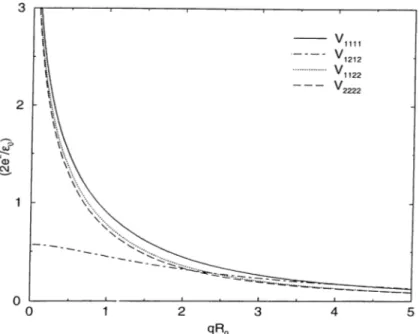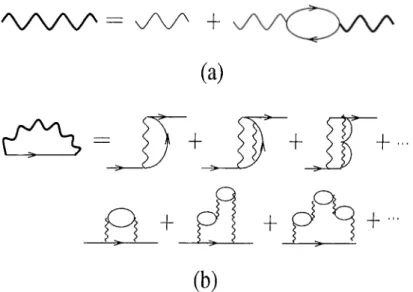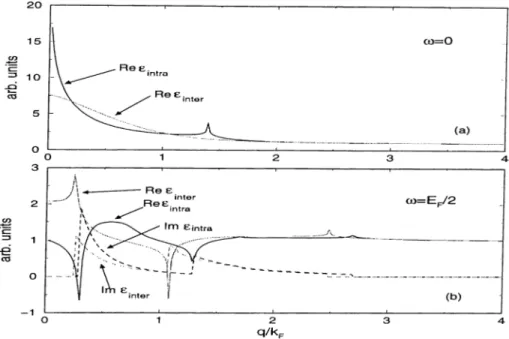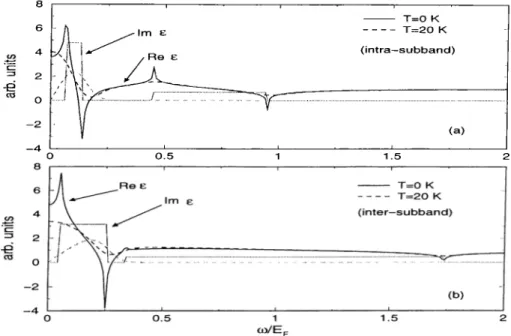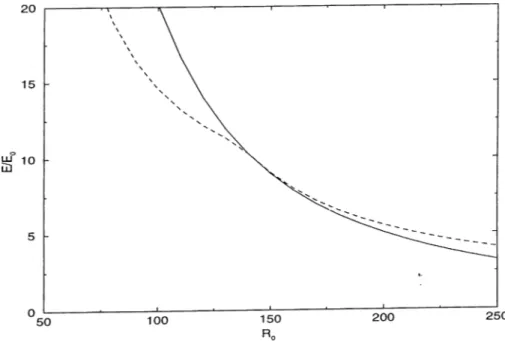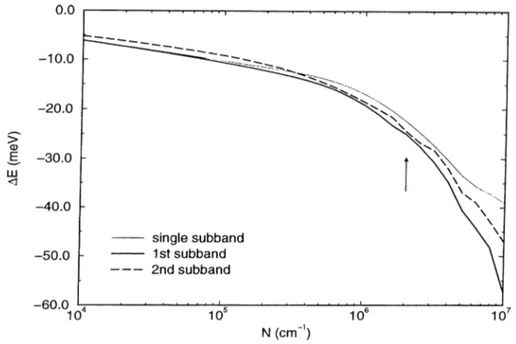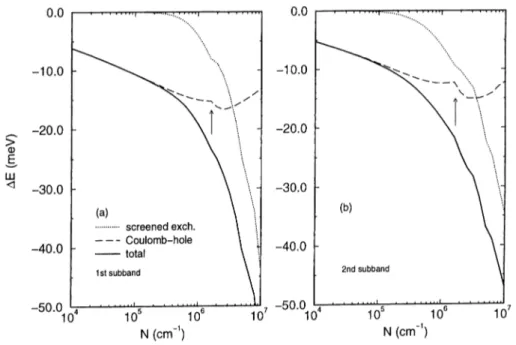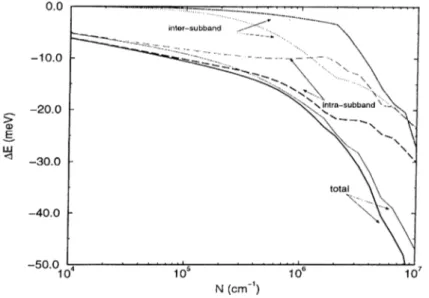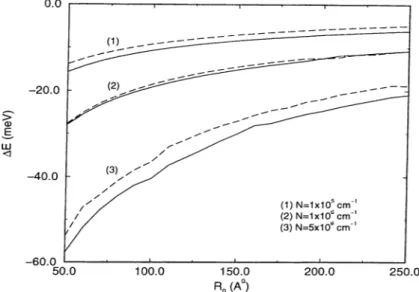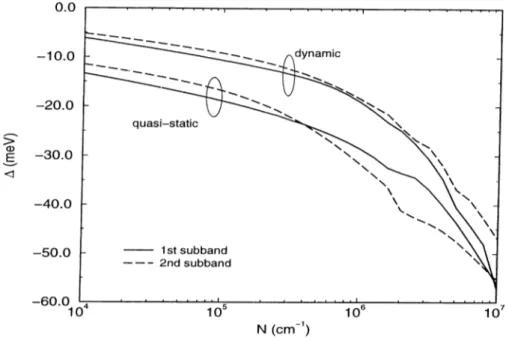s f f s c t s
a U A S ! -C M £- D \ MENSI OHhL· FH OTO-EXCI1 E.D
ELECTRON HOLE SYSTEM S
JhW»·» > V .SBU« ¡i^ · ?*»'><
Jv , tfMt W ·: V, ,,
FI -E.?,iTTT'B0' 'TO TM'E OEH.feEi ^ LLS:T- -
'-j*-vu~*i nr- I *,ir''*!.'*S"S··* t'T'ffi!· c > jr ;; rMSrriSD;'^Tf"« ¿'-■«‘v n SC^ FK^r'·^
Al^iO 1 HE IFIE’l;
II'U i £ Qi
^
.
^•C '0*r
-w
m
"^«1· 'i« mISSiM « « »fs«,i ?5*.is£“rii.f ii*i !'t ir’i'·' ' MCKjT ^si· T H E REQL-HHi'}’tii-!''X
r'-,STf:?.sss!!rc o c "
''''•sSr t:>xjx·!
V***»' •%<*»r^ -i ·* m 'iwi·^ « i* 'W ' « \i ^ u - i · ^ . ■ 'W ' ‘ »•H' •w* « » jfk
MANY-BODY INTERACTION EFFECTS IN
QUASI-ONE-DIMENSIONAL PHOTO-EXCITED
ELECTRON-HOLE SYSTEMS
A THESIS
SUBMITTED TO THE DEPARTMENT OF PHYSICS AND THE INSTITUTE OF ENGINEERING AND SCIENGE
OF BILKENT UNIVERSITY
IN PARTIAL FULFILLMENT OF THE REQUIREMENTS FOR THE DEGREE OF
Do c t o r o f Ph i l o s o p h y
by
Kaan Güven
September 1999
¿ с 4
9
4
‘И
Г -6 ,.Р .61 с
■I: і,I certify that I have read this thesis and that in my opinion it is fully adequate, in scope and in quality, as a dissertation for the degree of Master of Science.
I certify that I have read this thesis and that in rny opinion it is fully adequate, in scope and in quality, as a dissertation for the degree of Master of Science.
I certify that I have read this thesis and that in my opinion it is fully adequate, in scope and in quality, as a dissertation for the degree of Master of Science.
I certify that I have read this thesis and that in my opinion it is fully adequate, in scope and in quality, as a dissertation for the degree of Master of Science.
¿J. JcUë'na j
Assoc. Prof. Ulrike Salzner
I certify that I have read this thesis and that in my opinion it is fully adequate, in scope and in quality, as a dissertation for the degree of Master of Science.
Assoc. Prof. Engin Ôzda^
Approved for the Institute of Engineering and Science:
Prof. Mehmet Baray/
Abstract
MANY-BODY INTERACTION EFFECTS IN
QUASI-ONE-DIMENSIONAL PHOTO-EXCITED
ELECTRON-HOLE SYSTEMS
Kaan Güven
Doctor of Philosophy in Physics
Supervisor; Assoc. Prof. Bilal Tanatar
September 1999
The work in this thesis concerns rnany-body interaction effects in a quasi-one- dimensional electron-hole plasma, which may be generated under intense photo excitation in a semiconductor quantum-well wire. In particular, we investigate how these interactions affect the optical properties of the semiconductor quantum wire. We address this question in two parts: First, the band-gap renormalization (BGR) induced by self-energy corrections of electrons and holes is studied. A two subband model arising from the confinement of the quantum wire is developed to include the multisubband effects. The many-body theoretical formalism of electron (hole) self-energy is given within the G W approximation. We use the dielectric function both in full dynamical random-phase approximation, and in cjuasi-static approximation, in order to emphasize the dynamical properties of screening. The dependence of BGR on the e — h plasma density, temperature and wire width is studied.
In the second part, the exciton renormalization induced by e — h plasma screening, and Goulomb correlation effects on the optical spectra of a quantum
wire are considered. The optical properties are directly associated with the e — h
two particle propogator, which obeys the Bethe-Salpeter equation. Based on recent studies, we review the solution of this equation with screened Coulomb interaction. In particular it is shown* that the dynamical treatment of screening produces an optical absorption/luminescence spectra which is consistent with experimental results. We present a discussion on the interplay of excitons and unbound carriers and on the reflection of this interplay to the optical spectra.
Keywords: Quasi-one-dimensional dimensional electron-hole plasma, self-
energy, band-gap renormalization, T-matrix formulation, random-phase approximation.
*S. Das Sarma and D. W . Wang, “Many-body renormalization of semiconductor quantum wire excitons: absorption, gain, binding, unbinding, and Mott transition” , cond-niatt/9905038
özet
FOTO-IŞIMA İLE UYARILMIŞ BİREYAKIN BOYUTLU
ELEKTRON-DEŞİK SİSTEMLERİNDE ÇOK PARÇACIK
ETKİLEŞMELERİ
Kaan Güven
Fizik Doktora Lisansı
Tez Yöneticisi: Doç. Dr. Bilal Tanatar
Eylül 1999
Bu tez çalışması, bireyakın boyutlu elektron-deşik plazmasındaki çok parçacık etkileşmeleri üzerine yapılmıştır. Bu iki bileşenli fermiyon sistemi yoğun foto- uyarılma ile yarı iletken bir kuvantunı telinde oluşturulabilir. Tezin konusu olarak, bu etkileşmelerin yarı iletken kuvantum telinin optik özelliklerini nasıl etkilediği üzerinde durulmaktadır. Bu problemi iki bölümde ele aldık: İlk olarak, elektronların ve deşiklerin öz-enerjilerinden kaynaklanan bant aralığı renormalizasyonu ineelendi. Sistemin smırlandırılmasıyla oluşan altbant yapısı iki altbant kullanılarak modellendi ve çoklu altbant etkileri kısmen hesaba katılmış oldu. Elektron (deşik) öz-enerj isinin çok parçacık kuramsal forrnalizasyonu G W
yaklaşımı içerisinde verildi. Dielektrik fonksiyonu hem tanı dinamik rasgele- faz yaklaşımı, hem de yarı-statik yaklaşımla ele alınarak perdelemenin dinamik özellikleri vurgulandı. Bant-aralığı renorrnalizasyonunun e — h plazma yoğunluğu, sıcaklık, kuvantum teli genişliği gibi parametrelere göre nasıl değiştiği araştırıldı.
ikinci bölümde e — h plazma perdelemesi kaynaklı ekziton renornıaliza- syonunun ve Coulomb korelasyon etkileşmelerinin kuvantum telinin optik
özelliklerine olan etkileri incelendi. Optik özellikler e — h propagatörü ile doğrudan bağlantılıdır, ve bu iki parçacık propagatörü Bethe-Salpeter denklemiyle verilmektedir. Bu denklemin perdelenmiş Coulomb etkileşmesi olduğu durumdaki çözümünü yakın tarihli çalışmalara dayanarak inceledik. Özel olarak, dinamik şekilde ele alman perdeleme etkilerinin deneysel sonuçlarla uyumlu soğurma/ışıma tayfı oluşturduğu gösterildi.^ Genel olarak, ekzitonlar ve serbest elektron-deşikler arasındaki etkileşmenin optik tayf üzerine nasıl yansıdığı tartışıldı.
Anahtar
sözcükler: bireyakm boyutlu elektron-deşik plazması, öz enerji, bant
aralığı renormalizasyonu, rasgele faz yaklaşımı, T-matris formülasyonu.
tS. Das Sarnia and D. W . Wang, “Many-body renormalization of semiconductor quantum wire excitons; absorption, gain, binding, unbinding, and Mott transition” , cond-m att/9905038
Acknowledgement
I would like to express my deep gratitude to my supervisor Prof. Bilal Taiiatar, whose personal and academic virtue greatly shaped my approach to scientific study. With his intellectual humour, and friendly attitude, I have enjoyed his guidance throughout my entire Ph.D. study.
I would like to thank Dr. C. R. Bennett, Dr. N. C. Constantinou, and Prof. N. Balkan from the Department of Physics, Essex University, for their hospitality and collaboration during my visit.
I am indebted to my mom, my dad, and rny dear sister for their continous support and encouragement. (My particular compliments to my mothers delicious cuisine!)
Here is the crew (though the list is always incomplete!) who helped me to prolongate good times and shorten bad times: Özgür Müstecaphoğlu (aka Thall) has been a witty companion in our adventures^. Erol Sağol deserves special thanks for his warm friendship and support. Members of our diners club: Hüseyin Boyacı, Okan “Hodja” Tekman, Sencer Taneri. Alpan Bek, Ersin Keçecioğiu, ... Their presence kept me always smiling. Thanks, folks!
I would like to thank to our department secretary Ms. Benderlioghi, who helped me during the preparation of the manuscript.
And...thank you. Kedi. Simply because, you are there.
tK. Güven and Özgür Müstecaphoğlu, “Physicist’s Quest: An unfinished Tale” , (to be published...may be.)
Contents
Abstract i
Özet iii
Acknowledgement v
Contents vi
List of Figures viii
1 Introduction 1
2 Subband renormalization effects in a quasi-one dimensional
electron-hole system 5
2.1 Confinement Potential and the Effective Coulomb Interaction Matrix 8 2.1.1 The Confinement Potential (Quantum Wire Model) . . . . 8 2.1.2 Effective Coulomb Interaction M a tr ix ... 9 2.2 The electron (hole) self-energy T,{k,oj) within the G W approximation 12 2.3 The Dielectric Function... 15 2.3.1 The Matrix Polarizability Function 11;;/(ç, w ) ... 17 2.4 Screened Interaction Matrix W{q,u)) 19 2.5 Screened Exchange and Coulomb-Hole Decomposition of S(fc, 0») 21 2.6 The Quasi-static Approxim ation... 23 2.7 LO-phonon interaction e f f e c t s ... 24 2.8 Results For The Subband R enorm alization... 25
2.8.1 Finite Temperature E ffects... .32 2.9 Coupling to Bulk-LO P h on on s... 33 2.10 Beyond RPA: The Vertex C orrections... 35
3 M any-body effects on optical spectra of semiconductor quantum
wires: The interplay of excitons and free carriers 38
3.1 T-Matrix form ulation... 40 3.2 Low Temperature Limit 44 3.3 D iscu ssion ... 45
4 General conclusions 48
List of Figures
2.1 The effective Coulomb interaction matrix elements as a function of qR^. 12 2.2 (a) Dyson’s equation for the screened interaction, within the RPA. (b)
Electron (hole) self-energy in leading order in the effective dynamical screened Coulomb interaction... 13 2.3 The intra- and inter-subband dielectric functions as a function of q for
(a) u — 0^ and (b) u = Ep/2^ respectively. 20
2 .4 The intra-subband and inter-subband dielectric functions at q — k p / 2
as a function of scaled frequency. 21
2.5 The chemical potential of electrons as a function of d e n s i t y ... 27 2 .6 The chemical potential (dotted line) and the second subband level (solid
line) at = 1.4 X 10^ cm“ ^ as a function of wire radius... 27 2 .7 The subband renormalization as a function of density. 28 2.8 The screened exchange and Coulornb-hole contributions to the subband
renormalization as a function of density. 29
2 .9 The intra-subband and inter-subband contributions to the subband renormalization as a function of d e n s i t y ... 30 2 .1 0 The subband renormalization as a function of wire radius at various
densities. Solid (dashed) line indicates first (second) subband. 31 2.11 The full dynamical RPA vs. the quasi-static approximation 32 2 .1 2 Temperature dependence of the subband re n o rm a liza tio n ... 33 2 .1 3 Bulk LO-phonon coupling e ffe c ts... 34
2 .1 4 Vertex correction to the basic bubble diagram (shaded bubble). The right hand side represents the expansion in an infinite set of individual vertex lines which couple the propagators (upper and lower branches of
the bubble) via the Coulomb interaction. 36
3.1 The Bethe-Salpeter equation for the e — h pair propagator... 40 3 .2 Calculated absorption spectra for a GaAs quantum wire structure for
various photo-excitation densities by solving the full Bethe-Salpeter equation (a) quasi-static approximation, (b) dynamical approximation. (after Das Sarma et. ... 47
Chapter 1
Introduction
Reduced dimensionality in semiconductor structures reveals intriguing physical phenomena, which drive the interest to study these structures both from a fundamental physics point of view, and from a technological point of view. Two dimensional structures welcomed this interest by resulting in an enormous success in research and device applications. Based on this motivation, it was a natural trend to continue to reduce dimensions of semiconductor structures. Indeed, in the last decade much effort has been devoted to construct true one dimensional and zero dimensional systems, which are commonly referred to as “quantum wires” and “quantum dots” , respectively.
It might be instructive to clarify the reduced dimension concept at this point. We are not referring the reduction of dimensions in a strict mathematical sense, but rather as a consequence of the comparison of a length scale associated with physical processes, and the physical size of the system. Thus, reduced dimensionality can arise in many ways, depending on the physical process being considered. For our study, we are mainly concerned with the Fermi wavelength 2'K¡kF, as the typical length scale. When a sample dimension becomes comparable to this distance, the motion in that direction becomes quantized, resulting in changes in the energy spectrum and in the dynamical properties of the system. Therefore it is more appropriate to address these systems as “quasi- one-dimensional” .
CHAPTER 1. INTRODUCTION
Since the first suggestion by Sakaki^ and the experimental realization by Petroff et al? quasi one dimensional semiconductor structures have been an extensive research area. At present, quantum wires with active widths of about
100 Á, and of negligible thickness have been fabricated.
Much of the fundamental theoretical understanding of electrons in one dimensional systems has come from work on the Tomonaga-Luttinger model. The Tomonaga-Luttinger model makes some drastic simplifying assumptions which allow one to solve the interacting problem completely. One surprising result of this model is that any interaction present in the system results in a disappearance of the Fermi surface, leading to a system which is a non-Ferrni liquid (in the sense that the elementary excitations are very different from those of the noninteracting system). Therefore, one would expect that experimental properties of semiconductor quantum wires might be very different from any predictions based on the assumption that one-dirnensional electron gases are Fermi liquids. However, data extracted from experiments on these structures such as Raman scattering and photoluminescence have proven just the contrary, and shown that the results can be successfully explained on the basis of the standard Fermi-liquid theory. In general, interacting three-dimensional systems with and without disorder, and interacting pure two-dimensional systems are Fermi liquids. It has been shown^ that in the presence of impurity scattering (which is the case for a real system) one dimensional systems show Fermi liquid behavior, too. Based on these conclusions, we accept the validity of Fermi-liquid behavior without criticizing.
The work in this thesis focuses on some of the nonlinear optical effects in quasi-one-dimensional semiconductor systems, which are induced by many-body correlation effects. It is important to emphasize at the outset that reduced dimensionality by quantum confinement produces not only quantitative but also qualitative differences in the physics of these systems compared to that of bulk structures. The optical absorption spectrum gains some structure associated with quantum-confined electron and hole levels. Excitonic effects become much stronger because of quantum confinement, giving clear absorption resonances
CHAPTER 1. INTRODUCTION
even at room temperature. The relative importance of direct Coulomb screening and exchange effects is different, Coulomb screening being much weaker than in bulk and 2D cases.
The nonlinear optical response is different depending on whether virtual or real e —h populations are generated. In the case of virtual excitations, the amount of time photons spend in an excited state is r ~ AE~^ where A E is the difference between photon energy and excited state energy. Virtual transitions are therefore only favored under off-resonant excitation. The corresponding coherent optical nonlinearities are small, because of the large differences A E between photon energies and absorption edge.
Photo-excitation above the absorption edge generates real e — h pairs with no particular quantum-mechanical phase coherence. Due to strong absorption, such resonant excitation produces a large number of electrons and holes for a given laser intensity, and hence significant changes in the optical properties of the material. After being generated, electrons and holes undergo a number of relaxation processes; the changes they induce in the optical spectra are therefore limited to their lifetime. In semiconductors, they can form bound (exciton) or unbound (e — h plasma) states, which produce different effects. There are two relaxation times which should be distinguished. First is the time it takes the photo-excited electron and hole to reach a thermodynamic equilibrium among themselves. This lasts usually a fraction of a picosecond, thus the quasi equilibrium assumption is well justified unless one deals with ultrafast optical processes. Second, is the time it takes electrons and holes to (xpiilibrate with the lattice (in the picosecond range). Excitons that are generated by resonant excitation within the absorption peak are only stable at low temperatures. Since the two species have different effects on optical spectra, it is necessary to distinguish among them experimentally and theoretically. Our aim is to consider separately degenerate e — h plasma effects and excitonic effects on band-gap and optical absorption. We assume a dense electron-hole plasma generated under intense photo-excitation, thus, emphasis will be on effects due to free carriers. Yet, within the density range of interest, excitons are present on the low-density
CHAPTER 1. INTRODUCTION
part, and should be taken into aceount. We do this by formulating the problem as a single exciton embedded in a degenerate e — h plasma.
The thesis is organized as follows: In chapter 2, we describe the band- gap renormalization phenomenon in semiconductor structures and consider renormalization in a quantum wire. The subbands formed by the quantum confinement are taken into account. This leads to renormalization of the subband levels, and hence of the fundamental band-gap of the wire material. The dependence of renormalization on e — h plasma density, wire width, temperature will be discussed. Chapter 3 gives a review of recent studies concerning Coulomb correlation effects on optical spectra from quantum-confined systems, with emphasis on quasi-one-dimensional structures. Formation and stability of excitons in the presence of e-h plasma, and their optical properties are discussed. We conclude with general remarks in chapter 4.
Chapter 2
Subband renormalization effects
in a quasi-one dimensional
electron-hole system
When a dense electron-hole plasma is generated in an intrinsic semiconductor by intense photo-excitation, exchange-correlation effects among the carriers modify the properties of the semiconductor which are based on a single particle approach. In particular, the band-gap of the material is reduced, which is usually referred to as the “band-gap renormalization” (BGR) effect. Renormalization causes increasing absorption in the spectral region below the lowest exciton resonance. As substantial amount of carrier population may be induced by optical excitation, the renormalized band gap can affect the excitation process in turn and lead to optical nonlinearities. Band gap renormalization as well as various optical properties of the QID electron-hole systems have been studied^'^^ similar to the bulk (3D) and quantum-well (2D) s e m ic o n d u c t o r s w h e r e generally good agreement with the corresponding m easurem ents^^exist.
Density dependence of the BGR in QID systems was first considered by Benner and Haug® within the quasi-static approximation. Hu and Das Sarrna^ calculated the BGR neglecting the hole population and considering an electron plasma confined in the lowest conduction subband only. Tanatar'·^ studied the
BGR in a QID electron-hole plasma by employing the quasi static approximation. Campos Degani and Hipólito presented exchange and correlation effects in a Q ID gas using the self-consistent field method proposed by Singwi at.
In low dimensional structures most often made of polar compound semicon ductor materials, one has the additional complication of the long-range Fröhlich interaction between the charge carriers and the LO-phonons which also contribute to the renormalization processes. As the relevant energy scales in the problem, namely electron and hole Fermi energies, the dynamical plasma frequencies, and the LO-phonon energy become comparable, one faces an entangled many-body problem of electrons, holes, plasrnons and LO-phonons, where electron-electron and electron-phonon interactions should be treated on equal footing. These polaronic renormalization effects have been subject of some recent studies.
Despite these intense theoretical efforts, recent experimental studies reflect the fact that the BGR is still a controversial issu e.T h eoretica l results usually predict rather large band-gap shrinkage (about ~ 20meV).^’·^ Even though there is general consensus about the reduction of BGR in low dimensional systems, quantitative assessment of the density dependence of the BGR is still a subject of debate.
In this chapter, the many-body theoretical formalism of the subband renormalization will be given. Our main contribution here is to extend it to a multisubband formalism, and present explicit results. As indicated before, renormalization of the band structure is associated with interaction effects in the electron-hole plasma. Basically, we have to calculate the “renormalized” quasi-particle energy, which consists of the noninteracting particle energy and the interaction energy. The interaction energy is given by the “self-energy” of the particle. Hence, the renormalization of the subband is equal to the real part of the self energy of the particle (electron, hole) in that subband. For an electron-hole system this can be formulated as
CHAPTER 2. SUBBAND RENORMALIZATION EFFECTS IN ... 6
CHAPTER 2. SUBBAND RENORMALIZATION EFFECTS IN ...
where Aj denotes the renormalization of the ith subband.
This chapter is organized as follows: We first choose the confinement potential which models the wire, and obtain the corresponding effective Coulomb interaction matrix to be used. Then the main framework of our calculations, namely the self energy will be given. We use the so-called G W approxirnation^''’“'^^’ in calculating self-energy. Screening properties are described via the matrix dielectric function within the random-phase approximation (RPA). Using the effective Coulomb interaction matrix and the matrix dielectric function we construct the screened interaction matrix, which is the main ingredient (the
“W ” o f the G W approximation) in the self energy. Finally, the explicit form of the self energy within the dynamical random-phase approximation and the quasi-static approximation employed to the screening function will be presented. The relevant parameters that affect the renormalization are the e — h plasma density, the width of the wire, and the temperature. We discuss in detail the dependence on these parameters. Next, the electron-LO-phonon coupling and its effect on the renormalization process will be considered. Finally, we discuss the so-called vertex corrections that go beyond the random-phase approximation. These corrections are expected to improve the RPA result in the low density regime, where correlations are accounted for more accurately.
It might be convenient to indicate the “hidden” but crucial approximations simplifying the model here; The electron-hole gas consists of only one kind of electrons and holes with isotropic, parabolic dispersion and it is assumed to exist in a direct gap semiconductor. Thus, most of the band-structure complications of the valence subbands are neglected, and the band shifts are assumed to be rigid. This should be an adequate approximation for calculating the band-edge renormalization. Similarly, the effective mass approximation is expected to hold under the experimental conditions.
2.1
Confinement Potential and the Effective
Coulomb Interaction Matrix
2.1.1
The Confinement Potential (Quantum Wire Model)
The subband structure of a quasi-one-dirnensional system is determined by the confinement potential. Optical spectroscopy of quantum well wires (QW W ) reflects two different confinement regimes depending on the actual size of the quantum wire. In the weak confinement regime (i.e. when the confinement is larger than ~ ao where oq is the excitori Bohr radius) the optical response of the Q W W is dominated by the quantization of the center of mass motion of the exciton. In this case, the wide lateral potential of the large wire does not influence the electron and hole envelope functions. The main effect of the lateral boundaries is to confine the envelope function of the exciton as a whole. In the strong quantization regime, the confinement effects modify the single particle states. Experimental studies show that one has to fabricate very narrow QWWs (below 50 nrn) in order to obtain real ID quantization.'^^ Our work will be restricted to this regime.
For theoretical formulation, we choose our model wire as a circular cylinder of radius R() with an infinite potential barrier at r = Rq. The envelope functions of electrons and holes in the r plane can be calculated using the Schrödinger equation in polar coordinates:
CHAPTER 2. SUBBAND RENORMALIZATION EFFECTS IN ... 8
T ( _______
2m, V r dr rn dr^ /J-.2 d(j)^ <(r, <A) = [B - V(r, 0)1 C(r, 0), (2.2)
with.
V{r) = 0, r < Rq oo, r > Ro
The envelope functions are given in terms of Bessel functions as
1 •Jn i.inl )
(ttÄq) 2 [Jn+l{:}nl)_ ^±in(f)
(2.3)
with the indices n = 0 ,1 ,2 ,... and / = 1,2,.... J„ is the Bessel function of order n and jni is its Ith zero. The energy levels are
CHAPTER 2. SUBBAND RENORMALIZATION EFFECTS IN... 9
Eni =
2mRl (2.5)
Other geometrical models used in the literature are rectangular and parabolic confinements. From electrodynamics point of view, the presence of the electrons and holes should be taken into account when calculating the effective potential. This amounts to a numerical solution of the Schrödinger equation coupled to the Poisson equation, which has been considered in some studies^®’^® concerning the self consistent electronic subband structure of a quantum wire.
2.1.2
Effective Coulomb Interaction Matrix
For a system with cylindrical symmetry, the interaction potential between an electron at r and an electron at r' is given by
V ( T , r ' , q ) = — K „ ( q \ T ^ r ' \ ) , ^0
(
2
.6
) where Kq is the modified Bessel function. Eq is the static dielectric constant, ande denotes the electronic charge. The confinement potential modifies the Coulomb interaction by weighing it with the wave function and this is represented by a form factor. For our model we have
2e^
Uklmnill) ~ Eklmn{,Q^y Co
(2.7)
with the form factor.
Fklmnil) = f J
* '
(t(rK l(r')K o(? |r - r'l) C<I.(’'')C»('').
(2.8) The above matrix element can be interpreted as the scattering of two carriers from initial subbands k, I into subbands rn, n, respectively. Consequently, Kini isCHAPTER 2. SUBBAND RENORMALIZATION EFFECTS IN .. 10
an intra-subband interaction with all carriers remaining in the hrst siibband, V1221
describes the scattering of two carriers in first and second subbands respectively, where no inter-subband transitions are induced, and V1122 is an inter-subband interaction in which both carriers are scattered from the first subband to the second subband. Interactions that couple inter-subband and intra-subband modes (e.g. Vin2,Vi222) are not allowed in the symmetric confinement, due to the definite parity of the envelope functions. This fact is formulated by the following identity:
klmn
0
if k-\-l + m + n = odd. (2 .9 )and the form factor remains the same under all possible permutations of first and second pair of indices among themselves.
The form factor integral has, to our knowledge, no analytical form. Gold and Ghazali'^*’ presented analytical results for the form factor by employing approximate wavefunctions for ground state and first excited state (irrelevant quantum numbers are suppressed).
Ci(^·) =
,,2
2
1 - 1^2 l · C2( r ) =12 ,,3
, 7ri?g V " ' V 7r /î g Rf)^
with the corresponding subband energies (in Rydberg),
r < Ro, (2.10)
E, = 6 (
2
.11
)where denotes the excitonic Bohr radius. We refer the reader to the reference'^“ for the details of the calculation and cite the matrix elements of the form factor relevant to our formulation:
2304
+ U x ) K J x )
6 96 640 ^ ^ ^ ^
(
2.
12)
CHAPTER 2. SUBBAND RENORMALIZATION EFFECTS IN ... 11 Fli22 — 9216 K , { x ) { h { x ) - - ^ E ( x ) (2.14) E2222 36864 x'^ 1 .x·'^ + 2.x2 15 960 13440 /3(1) - ® A ( i ) ) (^K,{x) + ~^K4x (2.15) where x = qRo, and /„((c) and /<’„(x ) denote modified Bessel functions of the first and the second kind, respectively. The following asymptotic expressions are useful for numerical purposes
F n n { q R o <C 1) = — [in [ ^ ] [ l + g (qRo)^ + ^ { ( i R o T + 211(3^5'{(iRoY^ + · · -j
+ + (2.16)
Fii22{(lB.o <C 1) — 0.43 - I n
[2.23+
1
.
2
((
7
i?o)"] -
0
.
46
(r
7
/?o)
fmzii/Jio < 1) = =
(1
- 0.6(<//i,)‘ + 1.66(<;7?o)'')
(2.17) (2.18) E2222((/R-0 1) — — In qRo 2 l + - ( q R o r T · · · 617 1 ^ ■3 i 247 3360 + C.· - < ^ / 5 ) + (2.19)
where = 0.5 7 7 ... is Euler’s constant.
The effective Coulomb interaction is plotted in Fig.2.1 for a wire radius of
/?,o = 100 A . V1212 is a weak interaction and approaches a constant value as qR^o —>■ 0, as can be seen from the asymptotic expression, whereas other interaction elements obey the usual logarithmic behavior for the Coulomb interaction in ID.
CHAPTER 2. SUBBAND RENORMALIZATION EFFECTS IN ... 12
Figure 2.1: The effective Coulomb interaction matrix elements as a function oi qR.Q.
2.2
The electron (hole) self-energy
E{k,uj)
within
the
GW
approximation
Generally, it is not possible to calculate 'E{k,uj) exactly for interacting systems, and one must resort to various approximation schemes. In particular, self-energy of the Tornonaga-Luttinger model in one dimension can be calculated exactly. However, the connection between the exactly-solvable but artificial Tornonaga- Luttinger model and real semiconductor quantum wires is somewhat tenuous, and calculations based on more realistic models are required to make comparison with experiments. We follow the formulation developed by Hu and Das Sarrna^ for the self-energy of electrons in a quantum wire. In their model, the electrons (holes) have a parabolic dispersion in the propagation direction of the wire, and the electrons (holes) interact via exact Coulomb interaction. Unfortunately, with these assumptions, the problem can no longer be solved exactly. Hu and Das Sarma employed the G W approximation to calculate the self-energy,^® where the Green’s function is dressed by the dynamically screened Coulomb interaction.
CHAPTER 2. SUBBAND RENORMALIZATION EFFECTS IN. 13
which is calculated within the random-phase approximation (RPA). The Feynman diagrams for the Dyson’s equation of the screened interaction and the self-energy in this approximation are shown in Fig.s 2.2(a) and 2.2(b).
+
(a)
+ + +
(b)
Figure 2 .2; (a) Dyson’s equation for the screened interaction, within the RPA. (b) Electron (hole) self-energy in leading order in the effective dynamical screened Coulomb interaction.
In figure (a), the thin wavy line is the bare Coulomb interaction, the ellipse denotes the electron-hole polarization bubble. In figure (b), the straight line denotes the bare Green’s function and the thick wavy line denotes the dynamically screened interaction. Right hand side shows the terms present in the RPA
Here, we outline the rnultisubband formalism which was also described briefly by Hu and Das Sarma.^ Basically, for extending the single subband formalism to the multisubband one, the functions and equations will be recast into matrix form.
The Green’s function for the interacting electron-hole system obeys Dyson’s equation, which we write formally in matrix form below {k and lo denote the wavevector and frequency, respectively):
CHAPTER 2. SUBBAND RENORMALIZATION EFFECTS IN ... 14
Here, C^{k,üj) is the noninteractiiig Green’s function, and t,(k,uj) is the self energy, which includes all (i.e. infinite number of) interaction terms. In the weak coupling case (which corresponds to the high density limit for the electronic system), one can expand the self-energy in a perturbation series. In particular, the GhF-approximation uses the leading term in this expansion. The explicit form o f noninteracting Green function is
ni'
i n
(
2.
21)
where ^ ^ + Eii — is the kinetic energy at subband I' relative to the chemical potential //. Solving the Dyson’s equation gives
G
{& )
- i S (2.22)The quasiparticle energies are then given by the poles of G i.e. at the frequencies such that det \^G°^ — S 0.
The self energy in the G W approximation'^^ which is attached to external electron (hole) lines from subband i and j is given by
m k , i o ) = t ^ 2 k f , T ^ i^ W u ij{q ,o j„,)G U k + q,uj+oJrn), (2.23)
where the first sum is over the subbands (f = 1, 2) , and the second sum represents the sequence of Matsubara frequencies u)„,. = 2rrmkBT, with m = 0,1, 2,... kHq;,,. is the screened interaction matrix element between scattering states i j, and I n. Eqn. 2.23 is the main result of the subband renormalization problem. Dyson’s equation for the screened interaction for the random-phase approximation is (see Fig. 2.2(a) for the diagrammatic representation)
W = V + V P W , (2.24)
CHAPTER 2. SUBBAND RENORMALIZATION EFFECTS IN ... 15
be solved by introducing the dielectric matrix
e = l ~ V P , (2.25)
and the result is
W = r ^ v . (2.26)
Eqn. 2.26 defines the screened interaction matrix.
2.3
The Dielectric Function
Screening is the response of a charged many-body system to an electric field in a way that will cancel the field strength at large distances. Our concern here is the Coulomb interaction between two charges, in the presence of an electron hole plasma. The dielectric function carries all the wavevector and frequency dependence information of the screening in the system. The full derivation of the dielectric function is beyond our intentions, hence only the main features clarifying to the random-phase approximation are presented below.
The definition of the dielectric function in the interaction representation is given by^^ e{q 1 M - = 1 - V ( q ) dT<f , VjJ) ./() TrS{(I)p{q,T)p{-q,D
W ) )
(2.27)The function e{q,uj) is the retarded function obtained from e{q,iu) by the analytical continuation ioj —> u + iS. In Eqn.2.27, V{q) denotes the bare Coulomb interaction, {Trp{q-,T)p{—q,Qi)) is the density-density correlation function. Here,
p { q , T ) = e„r //o
E
Lp,o--tHo (2.28)
is the density operator in the Heisenberg picture. The Hamiltonian of the noninteracting system is given by Hq = iS-matrix which governs the evolution of the system from noninteracting to interacting
CHAPTER 2. SUBBAND RENORMALIZATION EFFECTS IN ... 16
case. The exact evaluation of this correlation function may be written as
/ '
./0 {Trp{q,T)p{~q,0))
P{q, ioj)
1 - V{q)P{q,iuj)’ (2.29)
where P{q,i^) denotes the polarization function. The polarization function consists of summing of all “different” polarization diagrams arising from the expansion of the 5-matrix. This can be written as an expansion P = p d ) + p(2) --- -pjjg random-phase approximation approximates the exact polarization diagram by its first term, which is P^^^q^co) (the polarization bubble in Fig. 2.2(b)). Thus, the corresponding RPA dielectric function is
1
£rpa
1 +
F ( i /) p d )
1 - V{q)PLP (2.30)
which gives e/fp/i = 1 — V{q)P^^^q,ioj). This derivation makes clear the approximate nature of the RPA. The total polarization operator P{q,iuj) has an infinite number of terms, while the RPA retains one. The RPA dielectric function was originally derived by Lindhard for a 3D electron gas.'^’
The RPA polarization function can be evaluated as
pd)(g^
ioj)= - I dr
{Trp{q, T)p{-q,0))
J 0
«/'■ i^k+q) - riF ( 6 )
? ifc+17 ^k tCJ
(2,31)
where np(^fc) denotes the Fermi distribution function.
In our model, the quantum wire is an intrinsic semiconductor, having equal electron and hole density. Thus, we can treat the screening by electrons and holes on an equal footing and write the total RPA polarizability as a sum of individual polarizability functions
p (b = p 0 ) + p0)_ ^2.32) In the case of doped n- type and p- type semiconductors, screening by electrons and holes should be considered separately.
CHAPTER 2. SUBBAND RENORMALIZATION EFFECTS IN 17
2.3.1
The Matrix Polarizability Function
Uii'{q,ixj)
In Eqn. 2.25, the components of the RPA polarizability function matrix are given by
Pijw{(li^) = (2.33)
Here, liii! denotes the multisubband generalization of P b ) (Eqn. 2.31)
n.w((/, w) = 2 y"
2TT if'·
C , i f ’ "
-(2.34)
where = ~ + E i— /j, is the kinetic energy at subband I relative to the chemical potential fx, and nj? is the Fermi function.
M ^ ) = -¡Ti
1
/T + 1 · (2.35)
Using the Dirac identity given below, one can obtain the real and imaginary parts explicitly
./■(^) ^ f ./( ^ ) ■ = V
z — ZoT'iO+ \z — Zo
where V denotes the Principal value integral·^*^
± - Z o ) , (2.36)
i+°o dk
-oo 2?!
.. ( i f )
.. ( i f ’)
^ - 1 ^ -0 0 + AE,i' m 2m “ rri + 2m + AE„''kq q^
ReH;// (g, u) =^2V J
Irnn,r (g, w) = -27T — [np (¿ 'jJ - n,d ^ ~
(2.37)
(2.38) where AEiv = Ei — Ei' denotes the subband separation energy.
Zero Temperature Case:
At zero temperature, /i = Ei?, and the Fermi function reduces to a step function.
CHAPTER 2. SUBBAND RENORMALIZATION EFFECTS IN... 18
where kp) = [2m{Ep' — Ei)]^^^ Q{Ep· — Ei) is the Fermi wavevector for the /th subband. The integral in Eqn. 2.37 can be evaluated analytically. This gives,
m Refl^;' {q, uj) = — T(q In wfi ^ + w — NEiw - u ) T AE,w + ln — w T AE\w Imll//' {q, a;) = [0 ^ - w + AEw 0
0 + C J - AEw
0
+ cu — AEw ^ + u — AEw T AEw (2.40) (2.41)where u)± — ± The matrix polarizability function [Eqn.s. 2.40 and 2.41] has following properties:
H u' {q ,^) = n / i '( —g, w ). (2 .4 2 ) R en,/i(</, - a ; ) = R eri;;/(i/, w ). (2 .4 3 ) Ir n n ;//(i7 ,-w ) = -I m r ii//(f7 ,a ;), (2 .4 4 )
and Ylw {q, co) = 0 if both Ei > Ep and Ei> > Ep is valid.
Finite Temperature Case
We apply the formalism developed by Maldague^^ to obtain the finite temperature expressions starting from the zero temperature formalism. In order to evaluate Eqn. 2.37 we use the following integral representation of the Fermi function
J 0
(2.45) 4Tcosh^ [ ( / / - / / ' ) /2 T ]·
Substituting in Eqn.2.37 and performing the integral over k first, we obtain
roo
ReUw{q,co-,T,f,)^ d^'nw{q,0J-,T = O.fx'). (2.46)
J 0
The imaginary part can be evaluated in a straightforward way to yield.
CHAPTER 2. SUBBAND RENORMALIZATION EFFECTS IN ... 19 where, „(0 _ a± —
^ L
+ A E a ^ ± ^ q I 2rn. 1 2 + E ,,- /y„ (2.48)2.4
Screened Interaction M atrix
W(q,uj)
We can now construct the screened interaction matrix defined by Eqn. 2.26. Using Eqn. 2.25 the explicit form of the dielectric matrix is
(11) (22) (12) (21)
(11) 1 - I ^ iiin ii — V112 2II22 0 0
(22) — Vii22riii 1 —12 2 2 2 112 2 0 0 (2.49)
(12) 0 0 1 — Ei212lli2 1 ~ Ul212lli2
. (21) 0 0 1 “ I I212II12 1 ~ Ei212lli2
the numbers in the small parentheses denote the subband pair indices for guidance. It is then straightforward to invert this matrix and multiply by the bare Coulomb interaction matrix V{q). The final result is
W (11) (22) (12) (21) (11) V'mi(l-V2222ll22) + V,V¿.>ll22^ i n t r a C i n t r aI'll!! 0 0 (22) V\ 1 22 V2222(l-Vniini,) + V;^,,,2*^^" 0 0 ^ i n t r a ^ i n t r a u (12) 0 0 YmiL W i n t e r W i n t e r . (21) 0 0 W i n t e rVvn-2 W i n t e r (2.50) In this block diagonal form, the upper block represents the intra-subband interaction, whereas the lower block includes the inter-subband terms. Similarly, the dielectric function has the intra-subband and inter-subband components given respectively as
Sintrai.Qi [1 ^1111 (9)rill (^, w)] [1 ^2222 (d)n22 (d) ^)]
CHAPTER 2. SUBBAND RENORMALIZATION EFFECTS IN ... 20
q/kp
Figure 2.3: The intra- and inter-subband dielectric functions as a function oi q for (a) a; = 0, and (b) u = Ef'j2, respectively.
The dark (light) lines show the intra (inter)-subband dielectric functions. Solid lines denote the real part, dashed lines denote the imaginary part. Other parameters are:
N = 10^ c m - \ T = 0K.
Hntcr{(l,<^) = 1 - Vi2 12{(l) [Hi2{q,co) + ri2i(g ,w )]. (2.52) In Fig.2.3, the zero temperature inter-siibband and intra-subband dielectric functions are plotted as a function of q/kj.' for u = 0 (top) and to = F^f/ 2 (bottom ), respectively. Dielectric function is unitless. For a; = 0, the imaginary parts of both dielectric functions vanish. As q goes to zero, the divergent behavior of the Coulomb matrix elements dominate in the real part of eintra· The peak on the Reeintra is due to the logarithmic singularity in the polarizability functions.
In Fig.2.3(b), the to points where the intra (inter)-subband dielectric function vanish correspond to the intra (inter)-subband plasmon modes for given to. The spectrum of these collective excitations have been investigated by Hwang and Das Sarma.^^
CHAPTER 2. SUBBAND RENORMALIZATION EFFECTS IN ... 21 -e03 8 6 4 2 O - 2 - 4 - h Im e --- T=0 K --- T=20 K A (intra—subband)
¿1 V
... rrrr::---Figure 2.4: The intra-subband and inter-subband dielectric functions at g — kp'/2 as a function of scaled frequency.
The dark (light) lines show the real (imaginary) parts of the dielectric functions. Solid lines are for T = OK, dashed lines are for T = 20K. Plasma density is taken as
N = 10^ crrr^.
In Fig.2.4 we plot this time the cu-dependence of the intra- and inter subband dielectric functions for q = kj?/2. This figure gives a comparison of zero temperature and finite temperature behavior as well. Basically, finite temperature smears out the sharp features of the polarization functions.
2.5
Screened Exchange and Coulomb-Hole D e
composition of E(A;,a;)
The self-energy expression (Eqn. 2.23) may be decomposed'into parts which have physical meaning. One possible decomposition divides the self-energy into a screened exchange term and a Coulomb-hole term:^^
CHAPTER 2. SUBBAND RENORMALIZATION EFFECTS IN ... 22
The screened exchange term is given by /■ dq
. ) = - E I nr ( i S , ) - (2.54)
which differs from the simple exchange term by the screened interaction. Due to the Fermi distribution function, it strongly depends on occupation. Correlation energy is described by the so-called Coulomb-hole part. The name comes from the depletion shell (a “hole” ) around a charged particle due to the repulsive Coulomb interaction among similar charges, which leads to a reduction in quasiparticle energy. The Coulomb-hole part is further decomposed into line and pole terms,
" U)l + ( z ~ e g J
2
- E / e i h - i S , - d - ''«‘M ( i £ , - 4 ■ (2.55) Summation over Matsubara boson frequencies iun = i2TrnT, n = 0,1,2... is due to finite temperature formalism. The line contribution is pure real because
W{q.,—i(jj„) = W*{q^iujn) hence the only contribution to the imaginary part of Eii{k,oj) comes from the pole part. riB and np denote the Bose and Fermi distribution functions, respectively.
Equations 2.54, 2.55 give the full frequency, wavevector, and temperature dependent self-energy in the G W approximation with the RPA dielectric function. The retarded self-energy is obtained by setting z u> + iO'^. For the subband renormalization, we evaluate the real part of the retarded self-energy at the relevant subband edge (A denotes carrier type, i.e., electron, hole).
A j = ;^ R e [eL"> (*: = 0 ,o> = . (2.56)
At zero temperature the sequence of Matsubara frequencies becomes a continuum, and the summation is replaced by an integral over the frequency variable as 2TJ3ij„ I duj/2tt. Furthermore, the Bose and Fermi frequencies reduce to step
CHAPTER 2. SUBBAND RENORMALIZATION EFFECTS IN ... 23
functions. Hence the real part of the self energy contributions at zero temperature evaluated at the band-edge are given by,
Relir^ =
I ./0 ¿ I T
(2.57)
R,eE){ C h ) Y - / ' ^ f d^' (^i=o ~ 4^0 rTT. / ^ 1/ / M
27T
y
27T ^ /2 ^^
iUzTl)]- E /
[[Wuu {q,e« - eEo) -
Vuu{q)]][ - 0 (eiio - ei'Ol ·
(2-58)
2.6
The Quasi-static Approximation
The numerical cost of calculating the full frequency dependent self-energy terms is high, as it recjuires a summation (or an integral in T = 0 case) over frequencies. The quasi-static approximation^^’^^is introduced to remedy this computational cost. This approximation amounts to replacing the dielectric function by its static (i.e. (u = 0 ) value in the final expressions. This is different than the simple static approximation which would arise if the screened interaction in Eqn.2.23 is replaced a priori by its static value. This scheme leads to serious errors in the calculation of the correlation energy, as noted in the literature.
In the quasi static limit, only the fractional expression in the line term (Eqn. 2.55, first line) depends on the Matsubara frequency and that sum can be reduced to a functional form:
2T Y ___ t ____ + 1 coth
2T (2.59)
where we have used the mathematical identity.47 W N 1 2.x· ~ 1 coth (7T.x) = ---1--- ---ri:.
7T.X· 7T E
CHAPTER 2. SUBBAND RENORMALIZATION EFFECTS IN. .. 24
Previous studies'·*’^^ indicate that the quasi-static approximation tends to overestimate the correlation energy. When presenting our numerical results, we shall address this point and discuss the importance of dynamical correlations.
2.7
LO-phonon interaction effects
If we include coupling of the electron-hole system to LO-phonons, the corresponding phonon interaction potential should be added to the bare Coulomb interaction. Thus we replace the bare Coulomb interaction (Eqn. 2.7) as (the subband indices are suppressed)
V M -* V^niq.u,) = V(q) + V,u(q,ul), (2.61)
where the general form of the phonon potential is given by
Vph{q,<^) = \M{q)\^ D{q,u,u^). (2.62)
In this equation, \M{q)f is the squared matrix element of the interaction between the carriers and the phonons concerned, uj,, is the phonon frequency, and D{q,oj,(jjq) the phonon propagator given by^^ D(q,u),uj,,) — 2uj,,/ . For bulk phonons the matrix element is
|M(g)r = P ( g ) ^ ( l - ^ ) . (2.63) and if we further assume dispersionless bulk LO-phonons, we set u),, = This yields the final form of the effective interaction as
Kff(q,u) = V{q) 1 + LOL O
- ^ l o ^ O
CHAPTER 2. SUBBAND RENORMALIZATION EFFECTS IN ... 25
Using the Lyddane-Sachs-Teller relation eo/^oo = ^loI^to can write
V{q) Veff{q,0j) =
£ph{q, w) ’ (2.65)
where Eph{q, cj) = (α;^ — oj'Iq) / (a;^ — is the phonon dielectric function which screens the bare Coulomb interaction due to electron-phonon coupling. In our previous discussion of the dielectric function, we took Vph = 0 and employed the so-called eo approximation, which consists of replacing the high frequency dielectric function €co by Cq iii the Coulomb potential (Eqn. 2.7). Note that, if we
resort to the LO-phonon coupling via the £p/,,, we must undo the eo approximation. The rationale of the eo approximation is that, the main effect of the high-frequency LO phonons is to screen the Coulomb interaction, which is suitably accounted for by the replacement of eoo by eo- Das Sarma et investigated the validity of the eo approximation for the 2D and quasi-2D semiconductor quantum wells and concluded that for weakly polar materials (e.g. GaAs, InAs, Ge, Si) the phonon coupling effects are very well approximated by eo, provided that the carrier densities do not reach very high values. This is because with increasing carrier density, the Fermi energies become comparable to the LO-phonon energy which makes the cq approximation less appropriate.
In including LO-phonons one has to subtract the phonon self-energy, which is always present and can not be detected separately by experiment. In perturbation theory, the phonon self-energy (modified to our multisubband formalism) reads
1
-^ r o \ ^ /' dq Villi (q)
? /
which should be calculated for electrons and holes and added together.
(2.66)
2.8
Results For The Subband Renormalization
In this section, we present the results of calculations based on GaAs material parameters, which we summarize in Table2.1. We used the scaling based on
CHAPTER 2. SUBBAND RENORMALIZATION EFFECTS IN .. 26 nif, = 0.067 m,, = 0.457 eo = 13.74 Coo = 10.9 ao = 119.77 A Eo = 4.66Ryd
Table 2.1: GaAs material parameters used in the numerical calculations.
the three dimensional excitonic Bohr radius ao and excitonic Rydberg Eo- Das Sarnia et. indicated in that in quantum well structures, a proper scaling can give a band-gap renormalization expressed in units of effective Rydberg which shows a universality, independent of the band-structure details of the material and dependent only on the electron-hole density and the well width.
Typical electron-hole plasma densities generated by photo-excitation in experiments vary between 10'^ — 10® cm “ ^. In Fig. 2.5, the chemical potential of electrons is plotted for single subband model (thin solid line) and for two-subband model (thick lines), at various temperatures. For wire radius of Rq = 150 A ,
the first two subbands are located at 0 . 6 7 and 1.71 F'o, respectively. At zero temperature, the second subband starts to populate around F7 ~ 1.4 x 10® crn“ \ where the chemical potential within the two-subband model deviates from the single subband result. Increasing temperature smears the sharp change at the onset of second subband population (see the inset figure).
The second subband level (solid line) and the chemical potential at a fixed density (dashed line) are plotted as a function of wire radius in Fig.2.6. As the radius range and the density are close to experimental conditions, the two- subband model appears to be appropriate for calculating the renormalization effects.
As the formulation given in the previous sections has different aspects to compare, (e.g. single subband vs. two-subband, dynamic vs. quasi-static) a systematic presentation is appropriate. We first consider the full dynamical, zero temperature formalism and plot the subband renormalization as a function of density. Fig. 2.7 shows the results for single subband and two-subband formalisms for comparison.
The wire radius is taken to be 100 A . At low densities, the single subband (thin solid line) and two-subband (thick solid line) formulations give nearly same
CHAPTER 2. SUBBAND RENORMALIZATION EFFECTS IN ... 27
Figure 2.5: The chemical potential of electrons as a function of density
Wire radius is Ro = 150 A. Thin solid line is the single subband result. Two dash- dotted lines in the inset figure denote the first and second subband levels, respectively.
Figure 2.6: The chemical potential (dotted line) and the second subband level (solid line) at iV = 1.4 x 10® cm"^ as a function of wire radius.
CHAPTER 2. SUBBAND RENORMALIZATION EFFECTS IN ... 28
Figure 2.7; The subband renormalization as a function of density.
Wire radius is Rq = 100 A. Full dynamical RPA formalism at T = 0 K is used. Solid (dashed) line shows the first(second) subband. The thin solid line shows the single subband result.
renormalization values, but after the population of second subband, they deviate significantly. Interestingly, the renormalization of the second subband is cjuite close to the first subband. Although this looks peculiar, especially when the second subband is empty, a detailed inspection of the contributions to the total renormalization seems to give a reasonable explanation. For this purpose we plot in Fig.2.8 the screened exchange and Coulomb contributions to each subband, which are given by Eqn.s 2.57, 2.58, respectively. The screened exchange depends on occupation, and the second subband is less occupied than the first one. The subband wavevector is given by
^(¿) _ I
yj2m{EF - Ei, Ei < Ep(2.67) 0, otherwise
CHAPTER. 2. SUBBAND RENORMALIZATION EFFECTS IN ... 29
Figure 2.8: The screened exchange and Coulomb-hole contributions to the subband renormalization as a function of density.
exchange energy (Eqn. 2.57) separately,
rkO
ReE<r> = - 2 f - 2 f ' . (2.68) it is easy to see that the intra-subband contribution is zero unless the relevant subband is occupied, but the inter-subband contribution depends on the occupation of the other subband. Hence, the second subband acquires a finite contribution from the first subband throughout the whole density range, whereas the first subband gets this contribution only after the onset of the second subband population. The inter-subband interaction is smaller than the intra-subband one, but a direct comparison of the screened interaction strengths Wan and Wijij
is not as trivial as in the bare Coulomb interaction matrix elements, as these screened interaction elements possess intra-subband and inter-subband plasmon poles, respectively.
The dominant contribution at low densities comes from the Coulomb-hole term, but the general behavior of the renormalization is due to screened exchange
CHAPTER. 2. SUBBAND R.ENORMALIZATION EFFECTS IN ... 30
Figure 2.9: The intra-subband and inter-subband contributions to the subband renormalization as a function of density.
term. The Coulornb-hole contribution depends upon how effectively the Coulomb field o f the particle is screened and is relatively insensitive to the details of the subband occupation. At zero temperature, the intra-subband term of the pole part vanishes due to the Bose factor, but for the second subband, the inter subband term does bring a finite contribution.
Finally, we plot the inter-subband and intra-subband contributions separately. Fig. 2.9 shows these contributions along with the total renormalization. As expected, the inter-subband contributions are relatively small in the density range where the second subband is empty.
Based on the results depicted in figures 2.7 - 2.9 we conclude that a multisubband formulation gives different results compared to single subband formulation. The very presence of the second subband alters the renormalization process, and with the onset of second subband population,, the inter-subband contributions become significant. On the other hand, the subband separation remains rather insensitive to the renormalization, but seem to increase at very high density {N ~ 10^ cm “ ^). The width of the wire essentially determines the dimensionality of the system, thus it affects the subband renormalization
CHAPTER 2. SUBBAND RENORMALIZATION EFFECTS IN. 31
Figure 2.10; The subband renormalization as a function of wire radius at various densities. Solid (dashed) line indicates first (second) subband.
directly. Narrower confinement enhances the form factor and increases the interaction energy. Fig. 2.10 shows the wire radius dependence of the subband renormalization at different fixed plasma densities. For the top most curve, second subband remains empty throughout the given radius range, for the middle curve second subband starts to populate close to ~ 200 Â, and for the lower curve second subband is always populated. For very large radii, the two-subband formulation is likely to give worse results since the subband separation is small, and more subbands get populated.
In section 2.6, we have introduced the quasi-static formulation, which is widely used in the literature. Calculations based on this approximation in higher dimensions*^ led to the conclusion that the quasi-static approximation tend to overestimate the renormalization effects. Here, we make the comparison of dynamic and quasi-static approximations for a quasi-one-dimensional system. Fig. 2.11 shows the calculated renormalization. At low densities there is a considerable difference between the two approximations. The outcome of the quasi-static approximation is consistent with that of higher dimensions: it overestimates the renormalization. With increasing density, this discrepancy
CHAPTER, 2. SUBBAND RENORMALIZATION EFFECTS IN. 32
Figure 2.11; The full dynamical RPA v.s. the quasi-static approximation
decreases. This reflects the importance of dynamical screening effects at low density regime.
2.8.1
Finite Temperature Effects
In general, rnany-body calculations in inetals'^'·'^'’ have used the zero temperature formalism because the energy scales intrinsic to the problem (Fermi energy, plasrnon energy, etc.) are usually much larger than the temperature T. In semiconductors, especially in artificial structures of reduced dimensionality, because of the low electron densities and large lattice dielectric constants involved, the experimental temperature can be comparable to the intrinsic energy scales of the electron-hole plasma.
For a quantum wire density of 5 x 10^ crn^^, the Fermi ehergies are of order 10 rrieV ~ 100 K. Therefore, within the range of the plasma densities under discussion, the zero temperature formalism might be adequate for temperatures well below this value. Yet, a finite temperature formalism is needed to extend the results to room temperature (T ~ 300 K). For this purpose, we plot the
